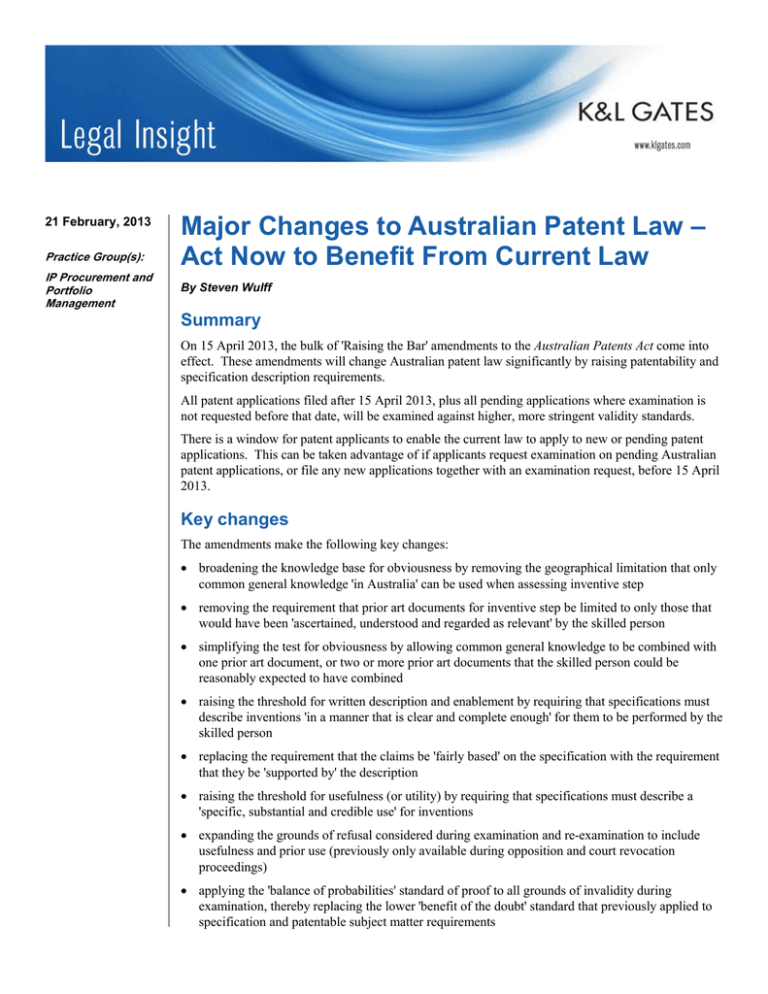
21 February, 2013
Practice Group(s):
IP Procurement and
Portfolio
Management
Major Changes to Australian Patent Law –
Act Now to Benefit From Current Law
By Steven Wulff
Summary
On 15 April 2013, the bulk of 'Raising the Bar' amendments to the Australian Patents Act come into
effect. These amendments will change Australian patent law significantly by raising patentability and
specification description requirements.
All patent applications filed after 15 April 2013, plus all pending applications where examination is
not requested before that date, will be examined against higher, more stringent validity standards.
There is a window for patent applicants to enable the current law to apply to new or pending patent
applications. This can be taken advantage of if applicants request examination on pending Australian
patent applications, or file any new applications together with an examination request, before 15 April
2013.
Key changes
The amendments make the following key changes:
broadening the knowledge base for obviousness by removing the geographical limitation that only
common general knowledge 'in Australia' can be used when assessing inventive step
removing the requirement that prior art documents for inventive step be limited to only those that
would have been 'ascertained, understood and regarded as relevant' by the skilled person
simplifying the test for obviousness by allowing common general knowledge to be combined with
one prior art document, or two or more prior art documents that the skilled person could be
reasonably expected to have combined
raising the threshold for written description and enablement by requiring that specifications must
describe inventions 'in a manner that is clear and complete enough' for them to be performed by the
skilled person
replacing the requirement that the claims be 'fairly based' on the specification with the requirement
that they be 'supported by' the description
raising the threshold for usefulness (or utility) by requiring that specifications must describe a
'specific, substantial and credible use' for inventions
expanding the grounds of refusal considered during examination and re-examination to include
usefulness and prior use (previously only available during opposition and court revocation
proceedings)
applying the 'balance of probabilities' standard of proof to all grounds of invalidity during
examination, thereby replacing the lower 'benefit of the doubt' standard that previously applied to
specification and patentable subject matter requirements
Major Changes to Australian Patent Law – Act Now to
Benefit From Current Law
preventing amendments of specifications to insert matter that extends beyond what was described
at the time of filing
shortening the time to obtain acceptance of an application from 21 to 12 months from the date of
the first examination report.
Many of these changes will be familiar to overseas applicants because they are intended to align
Australian patent law with other key jurisdictions, such as the US, UK and Europe.
Recommendations
To avoid the application of these significant patent law changes under the 'Raising the Bar'
amendments, applicants should consider taking the following steps well in advance of 15 April 2013:
request examination on pending applications
file planned or unfiled applications together with an examination request
for PCT applications due for national phase later in 2013, enter national phase early and request
examination at entry
if PCT applications have not been filed, file Convention applications and request examination at
filing
if provisional applications are due for completion later in 2013, file complete applications early
and request examination at filing
for pending applications describing multiple inventions, file divisional applications and request
examination at filing
for pending applications that would be improved by including additional examples or description,
file amendments adding such extra subject matter.
Please contact us in advance of 15 April 2013 to discuss options for your particular Australian patent
portfolio.
The above outline covers only a selection of key changes in Australian patent law and practice that
will be introduced by the 'Raising the Bar' amendments. We will continue to keep you informed of
further developments and considerations under these amendments.
Author:
Steven Wulff
steven.wulff@klgates.com
+ 61.3.9205.2147
2
Major Changes to Australian Patent Law – Act Now to
Benefit From Current Law
Anchorage Austin Beijing Berlin Boston Brisbane Brussels Charleston Charlotte Chicago Dallas Doha Dubai Fort Worth Frankfurt
Harrisburg Hong Kong London Los Angeles Melbourne Miami Milan Moscow Newark New York Orange County Palo Alto Paris Perth
Pittsburgh Portland Raleigh Research Triangle Park San Diego San Francisco São Paulo Seattle Seoul Shanghai Singapore Spokane
Sydney Taipei Tokyo Warsaw Washington, D.C.
K&L Gates includes lawyers practicing out of 46 fully integrated offices located in North America, Europe, Asia,
South America, Australia, and the Middle East, and represents numerous GLOBAL 500, FORTUNE 100, and
FTSE 100 corporations, in addition to growth and middle market companies, entrepreneurs, capital market
participants and public sector entities. For more information about K&L Gates or its locations and registrations, visit
www.klgates.com.
This publication is for informational purposes and does not contain or convey legal advice. The information herein should not be used or relied upon in
regard to any particular facts or circumstances without first consulting a lawyer.
©2013 K&L Gates LLP. All Rights Reserved.
3
